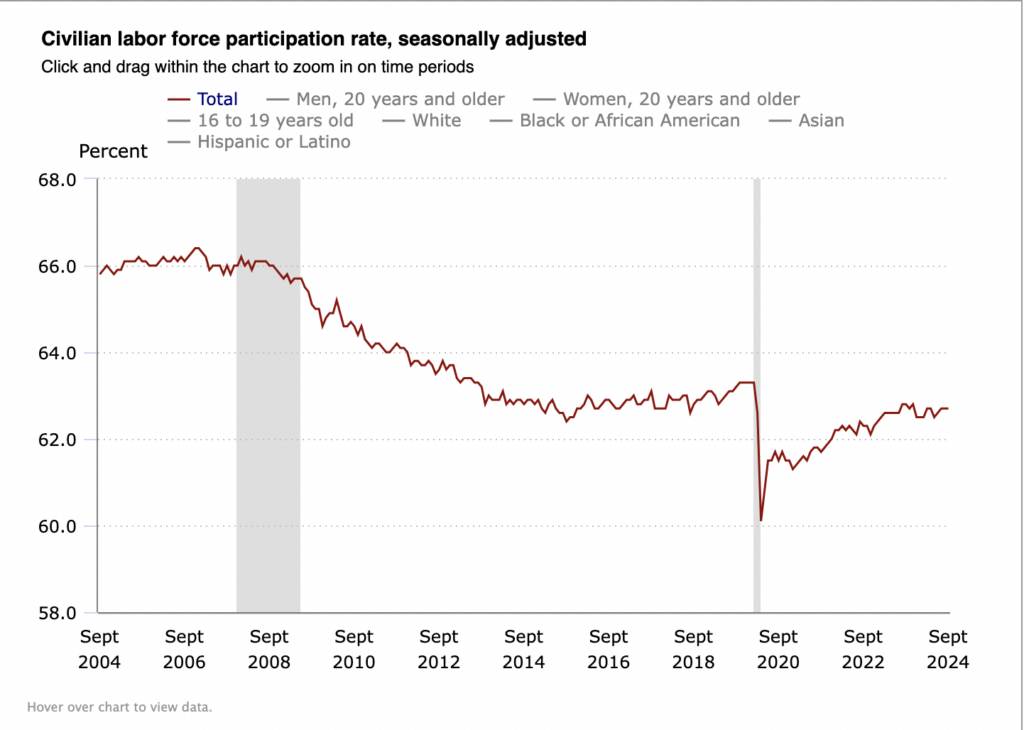Across American culture and dinner table discussions, a paradox: While economists and politicians say the economy is strong, unemployment is low, and hundreds of thousands of jobs are being added.
Meanwhile, millions struggle to find gainful, secure employments and make ends meet. Americans cite the economy as their top election issue, and a recent Gallup survey benchmarked the Economic Confidence Index at -26.
On top of that, a record 52% of Americans say they are worse off now than they were a year ago — the highest level ever recorded since the question started being asked 40 years ago.
Where is the disconnect? Are politicians and officials gaslighting the public?
While politicians and the mainstream media celebrate low unemployment, they miss important statistics that paint a more accurate picture of the state of the American economy.
Mass Layoffs
This year saw mass layoffs across the economy, particularly in high-paying, benefit-stacked professions such as tech and finance.
Since January 2023, more than 400,000 layoffs have been logged by data aggregator layoffs.fyi in some of the biggest names of the corporate world. Among them: Google, Facebook, Goldman Sachs, Intel, Cisco, and Salesforce. Those figures only reflect the formal, official layoffs — but not quiet layoffs.
The Bureau of Labor Statistics logs the current labor participation rate at a 62.7% — almost a full 2% less than the lowest level in the immediate wake of the Great Recession of 2008.
In fact, the labor participation rate has been on a fairly steady decline ever since.

While the employment market has partially recovered from the drastic drop of 2020, it remains almost a full percentage point lower than pre-2020 levels.
But zooming out, pre-2020 levels were already low and part of an ongoing 15-year downward trend.
High Unemployment Rates
Even these numbers don’t paint the full picture.
Every month, Wall Street applauds the robust economy and low unemployment rate. Despite a September jobs report — described as a “blowout” — the figures reported are hardly representative of the real state of the American job market or the direction it’s trending in.
The 4.1% unemployment figure, for one example, is one-dimensional in scope. It leaves out several other categories of unemployed persons, including those those who haven’t reported looking for work (which often ceases once unemployment benefits run out), and those working reduced hours due to business conditions.
The Bureau of Labor Statistics also reports on these categories its monthly jobs report as well in a group called “U-6.“
In September, U-6 was reported as 7.7%.
Moreover, long-term unemployment rates are up by more than 23% over last year’s figures.
The Shift to Contract Work
Meanwhile, a 2022 report published by McKinsey Research found that of those in the labor force, only 64% were full-time, W-2 employees.
Generally, W-2 employees are more financially, socially stable, and legally protected. W-2 employees are entitled to benefits, such as medical insurance and retirement planning through their employer.
The McKinsey report also captures that between 2017 and 2022, the percent 1099 employees of the total workforce skyrocketed from 27% to 36%.
A full 9% of the American workforce transitioned from benefited, legally protected W-2 positions to 1099 employment over a 5-year period. The McKinsey report figures are consistent data reported by Bureau of Labor and Statistics.
In 2018, the National Employment Law Project estimated that employers save approximately 30% in payroll expenses by classifying employees as 1099 rather than W-2.
Companies have been proactively to shift their workforce to 1099 employees in lieu of W-2 employees. The benefit to employers in that it shifts tax burdens onto the employee — cutting into their wages. Classifying employees as 1099 strips them of legal protections and benefits, like medical, unemployment, and disability insurance. It also means that employment can be dialed up and down or even terminated without any notice, reason, or insurance.
Many 1099 workers are gainfully self-employed. Typically, those operating small businesses are classified as “incorporated,” whereas those operating independently, selling services as freelancers and contractors do, are “unincorporated.”
The BLS reports that in Q4 of 2023, over 9 million workers were unincorporated 1099 employees, representing 5.7% of employed Americans.
In other words, much of the recovery from the pandemic has taken the form of less secure positions with no benefits or protections.
Combating Employee Misclassification
Earlier this year, the Biden Administration implemented a new regulatory rule to combat employers misclassifying workers as 1099 employees when the should be W-2s and entitled to all the benefits that come with it. Companies like Uber and Lyft have spent millions in legal battles and legislation trying to fight contractor versus employee classification legislation and regulation.
All together, between the shift from W-2 to unincorporated 1099, and those who fall in the Bureau of Labor Statistic’s “U-6” jobs report category, a sobering 13.4% of American workers are either fully unemployed or unprotected, underemployed 1099 employees.
That’s a far cry from the 4.1% megaphoned across headlines as reason to celebration, and hardly a robust indictor of a healthy economy.
Related: 40% of Companies Admit to Posting Fake Job Openings


